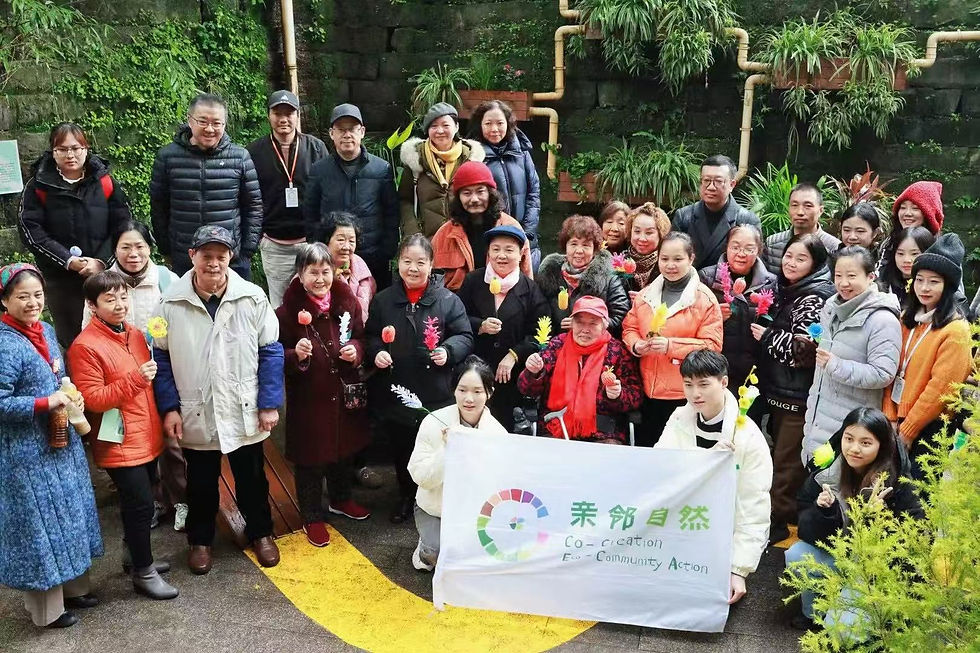
Memory Garden
"Memory Garden" is an aesthetic education program at the Xingjiaqiao Community Ecological Garden in Chongqing, integrating horticulture and ceramics to elevate the garden into a "place" that holds emotions. Elderly residents learn plant care and craft clay flowerpots, creating "memory vessels" for the "gardeners" in their lives. After kiln-firing, the pots are planted with flowers and placed in the "Memory Corner," fostering connections between personal and community emotions, transforming the garden into a communal "emotional archive."
1.1 Cultivating Community Emotional Space: Ecological Garden Construction
Based on the residents' opinions, the site for the ecological garden was chosen as a neglected community corner previously occupied by makeshift resident structures. This area suffered from poor maintenance and scattered litter, significantly impacting residents’ quality of life. Through multiple rounds of communication and surveys with residents, the project team decided to transform this space into an ecological garden. The transformation process began with clearing garbage and unauthorized structures, followed by foundational construction, including paving the ground, establishing seating areas, and creating planting zones. Through these efforts, the once-dirty corner was converted into a clean, aesthetically pleasing ecological garden, providing residents with a comfortable leisure space.

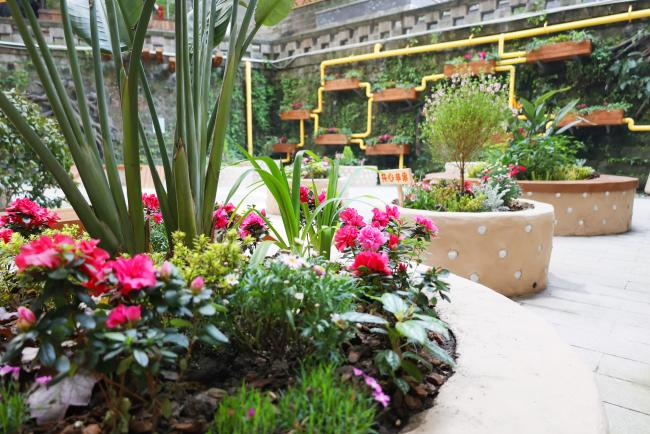
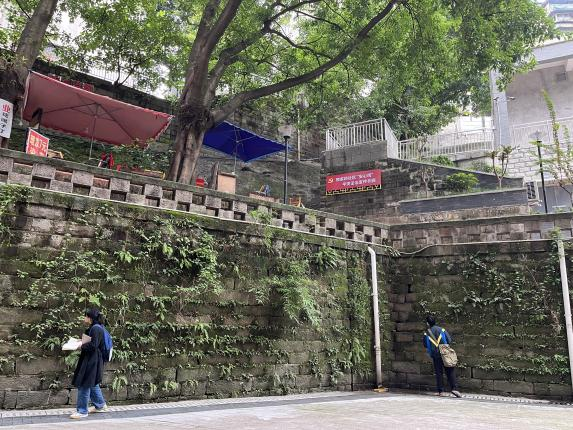
Building on the spatial transformation of the ecological garden, the project team initiated immersive, curriculum-based aesthetic education programs within the garden space. The planting areas were transformed into aesthetic classrooms, hosting themed workshops on seasonal flower arrangement and vertical greening installations. These activities allowed residents to directly experience the outcomes of aesthetic awareness cultivation. Additionally, the team encouraged residents to create ecological installations and artworks using construction waste, fallen branches, and leaves, producing visually appealing garden decorations through recycling. This practice deepened residents’ understanding of circular aesthetics. Furthermore, mentor-led aesthetic education courses, such as basic horticultural training, workshops, and lectures, were introduced to enhance residents’ aesthetic awareness. Through learning plant pairing and garden maintenance, residents improved their skills in sustaining the garden’s operations, reinforcing their aesthetic agency. These activities enhanced residents’ perception and appreciation of beauty, fostering greater care for the community environment and awareness of ecological responsibility.
1.2 Fostering Residents’ Aesthetic Awareness: Aesthetic Education Programs
To ensure the project’s long-term sustainability, alongside aesthetic education programs, the project focused on establishing resident volunteer organizations. By forming self-governance groups, residents could directly participate in the management and decision-making processes of the ecological garden. Regular meetings and open discussions encouraged residents to voice opinions, collaboratively develop plans for the garden’s growth, and address challenges in its construction. This bottom-up approach sparked residents’ initiative and creativity, transforming them from passive service recipients into active contributors to community development. This enhanced their sense of participation and the community’s self-management capacity, laying a solid foundation for the community’s long-term development.
1.3 Cultivating Community-Driven Momentum: Building Self-Governance Organizations

The construction of the ecological garden was not merely a physical transformation but also a nurturing of the community’s emotional space. The process fully respected residents’ opinions. The project team organized several participatory design workshops, inviting residents to share suggestions for the garden’s development. Residents actively engaged in discussions, contributing ideas on garden layout and plant selection. They also participated in hands-on construction activities, such as planting and building flower beds. This participatory approach fostered a deeper emotional connection to the garden, ensuring its design and functionality aligned closely with residents’ actual needs. The transformation of a privately occupied corner into a vibrant public ecological garden has made it a vital space for daily activities and emotional exchanges among community members.
Before
After
CO-CREATING ARTISTIC ACHIEVEMENTS
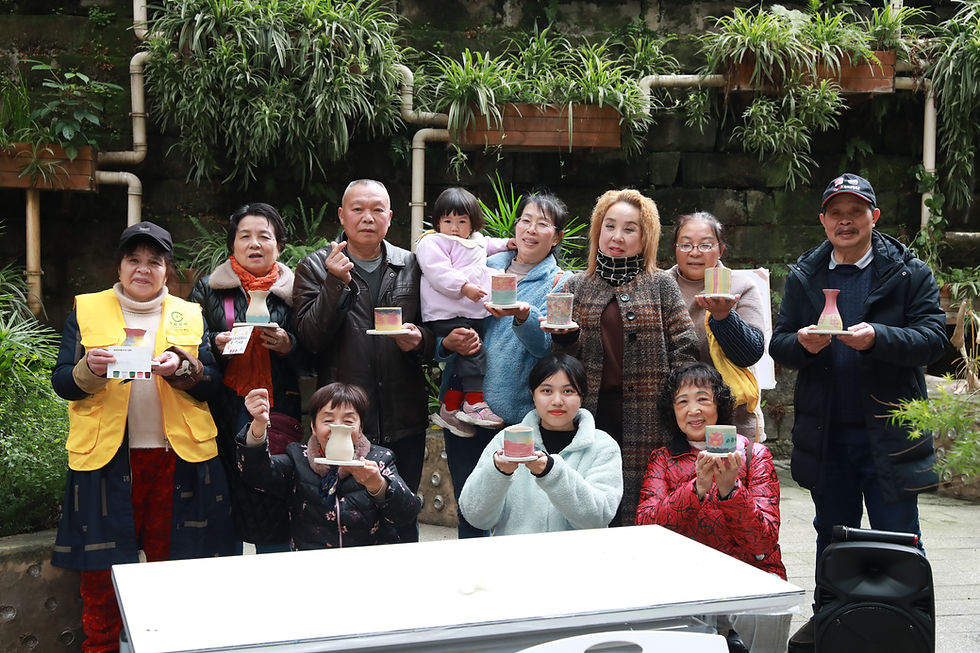



2. Why Choose Ecological Gardens as a Medium for Aesthetic Education for the Elderly in Communities?
Nature holds an inherent appeal for people, particularly the elderly. With age comes a wealth of life experiences and an appreciation for the cycles of seasons, fostering a deep connection to the constancy and change of nature. The beauty of natural landscapes provides psychological tranquility and harmony (Talbot & Kaplan, 1991). Aesthetic education practices centered on nature emphasize the role of appreciating and experiencing natural beauty in personal growth and education. As discussed earlier, aesthetic education is deeply tied to emotional development, and scholars have long explored the connection between nature and spiritual-emotional growth. For instance, 19th-century British Romantic poet William Wordsworth viewed nature as a source of beauty, a place that evokes profound emotions and introspection, serving as a sanctuary for the soul (Chen, 2002). The integration of nature and education gained prominence with the environmental education movement in the mid-20th century, which emphasized learning through direct experiences in natural environments. Since then, “nature-based aesthetic education” has been more widely recognized and practiced.
Ecological gardens, as a form of nature-based aesthetic practice, offer the elderly a novel aesthetic experience. The interaction between art and the natural environment amplifies positive emotional impacts, providing new perspectives for observing and understanding the world. This enables the elderly to enjoy aesthetic experiences while gaining insights into life philosophy and ecological wisdom (Yi, 2019). Within communities, ecological gardens serve as ideal venues for learning, leisure, and other activities. Aesthetic education programs conducted around these gardens enhance elderly residents’ social participation and emotional well-being (Kondo et al., 2018).
2.1 The Intrinsic Connection Between Ecological Gardens and Aesthetic Education for the Elderly
Stocker and Barnett (1998) categorize community ecological gardens into three types: a collection of individual plots, gardens cultivated collectively for the benefit of a working group, and plots designed for the broader community’s benefit. This study focuses on the third type—community-oriented ecological gardens. For individuals, these gardens, as mediums for aesthetic education, provide aesthetic value and experiences that positively influence participants, enhancing their perception and appreciation of beauty (Hale et al., 2011). They also serve as excellent platforms for sustainable development education (Corkery, 2004). At the community level, ecological gardens connect various aspects of the social-ecological system, fostering interactions among residents (Bendt et al., 2013). This aligns with the needs of aesthetic education for the elderly, as ecological gardens provide a space for engaging with nature and participating in aesthetic activities, thereby enhancing social engagement through community interactions.
2.2 The Role of Ecological Gardens in Nurturing Community Emotional Space
Ecological gardens in communities do more than provide physical spaces; they are vital carriers for cultivating emotional spaces. Aesthetic education programs centered around ecological gardens enhance elderly residents’ physical perception and interaction with community spaces, deepening their experiential understanding of the community. As phenomenologist Merleau-Ponty argued, space is experienced through bodily engagement and movement, with the body serving as the foundation for understanding and experiencing space, enabling individuals to construct their position and meaning within it (Ma, 2019). During the construction of the ecological garden—a tangible community space—activities such as infrastructure development, soil compaction, and flower planting allow residents to strengthen their spatial understanding and emotional connection through labor.
Additionally, as public spaces, community ecological gardens facilitate aesthetic education programs that encourage participants to integrate into these spaces, reshape their attitudes toward them, and foster a sense of place and belonging. This nurtures and develops community spirit (Janowska et al., 2022). In Space and Place: The Perspective of Experience (2017), Yi-Fu Tuan emphasized the role of personal experience in transforming physical space into a meaningful place. He distinguished space as an abstract, measurable, objective environment, while place is a specific space imbued with meaning through individual or collective experiences. Tuan argued that interactions with the environment create perceptions, memories, and emotions that render spaces meaningful, facilitating their transformation into places (Tuan, 2017). Conducting aesthetic education programs for the elderly during the ecological garden’s construction links physical space development with emotional education. This process transforms the ecological garden into a carrier of collective memory and a medium for emotional exchange, fostering an emotional community space and contributing to its transformation into a warm, meaningful place.
References
Bendt, P., Barthel, S., & Colding, J. (2013). Civic greening and environmental learning in public-access community gardens in Berlin. Landscape and Urban Planning, 109(1), 18–30. https://doi.org/10.1016/j.landurbplan.2012.10.003
Chen, C. Y. (2002). Nature brings joy and solitude to the heart: On Wordsworth’s view of nature. Journal of Sichuan International Studies University, (06), 33–36.
Corkery, L. (2004). Community gardens as a platform for education for sustainability. Australian Journal of Environmental Education, 20(1), 69–75. https://doi.org/10.1017/S0814062600002334
Hale, J., Knapp, C., Bardwell, L., Buchenau, M., Marshall, J., Sancar, F., & Litt, J. S. (2011). Connecting food environments and health through the relational nature of aesthetics: Gaining insight through the community gardening experience. Social Science & Medicine, 72(11), 1853–1863. https://doi.org/10.1016/j.socscimed.2011.03.044
Janowska, B., Łój, J., & Andrzejak, R. (2022). Role of community gardens in development of housing estates in Polish cities. Agronomy, 12(6), 1447. https://doi.org/10.3390/agronomy12061447
Kondo, M. C., Fluehr, J. M., McKeon, T., & Branas, C. C. (2018). Urban green space and its impact on human health. International Journal of Environmental Research and Public Health, 15(3), 445. https://doi.org/10.3390/ijerph15030445
Ma, Y. L. (2019). Body space and living space: Merleau-Ponty on body and space. Journal of Renmin University of China, 33(01), 141–152.
Talbot, J. F., & Kaplan, R. (1991). The benefits of nearby nature for elderly apartment residents. The International Journal of Aging and Human Development, 33(2), 119–130. https://doi.org/10.2190/6N0X-0NTA-M6RV-BM6M
Tuan ongel, Y. F. (2017). Space and place: The perspective of experience. Renmin University Press.
Yi, X. (2019). Ecological education through aesthetic engagement. The Journal of Environmental Education, 50(3), 183–191. https://doi.org/10.1080/00958964.2019.1607743
From 2022 to 2024, I participated in the preliminary phases of the Xingjiaqiao Community Ecological Garden Project in Chongqing as a volunteer and artist-teacher. The project has now transitioned from the stages of co-planning and co-construction to co-sharing and co-governance. As one of the art-based co-creation activities in the project’s later phase, the “Memory Garden” community aesthetic education course, designed and led by me, seeks to transform the community garden from a physical “space” into a meaningful “place” that carries emotional memories through the integration of horticulture and ceramics.
In the “Memory Garden” course, elderly residents learn to care for plants such as hydrangeas and gardenias while handcrafting clay flowerpots. Just as plants require nurturing and nourishment from gardeners to thrive, people’s lives are shaped by those who support their growth—perhaps a partner, parent, child, or friend. This activity encourages elderly residents to create unique ceramic “memory vessels” dedicated to these significant “gardeners” in their lives. By translating the appearance, personality, or hobbies of these individuals into patterns and colors on the flowerpots, each piece becomes a tangible expression of a personal story.
After being kiln-fired, the ceramic flowerpots are filled with plants chosen by the residents and placed in the “Memory Corner” of the community garden. These flowerpots serve as emotional links connecting individuals, families, and the community, endowing the garden with deeper significance. Over time, the community garden evolves beyond a space for plants to grow, becoming an “emotional archive” woven from countless cherished memories. Through the fusion of art and nature, “Memory Garden” transforms the community garden into a sanctuary for residents’ hearts, where every plant and every flowerpot carries love and memories, flourishing endlessly.
3. Course Design Concept
4.Course Participants
Elderly residents of Xingjiaqiao Community, Liangjiang New Area, Chongqing City (9 participants)
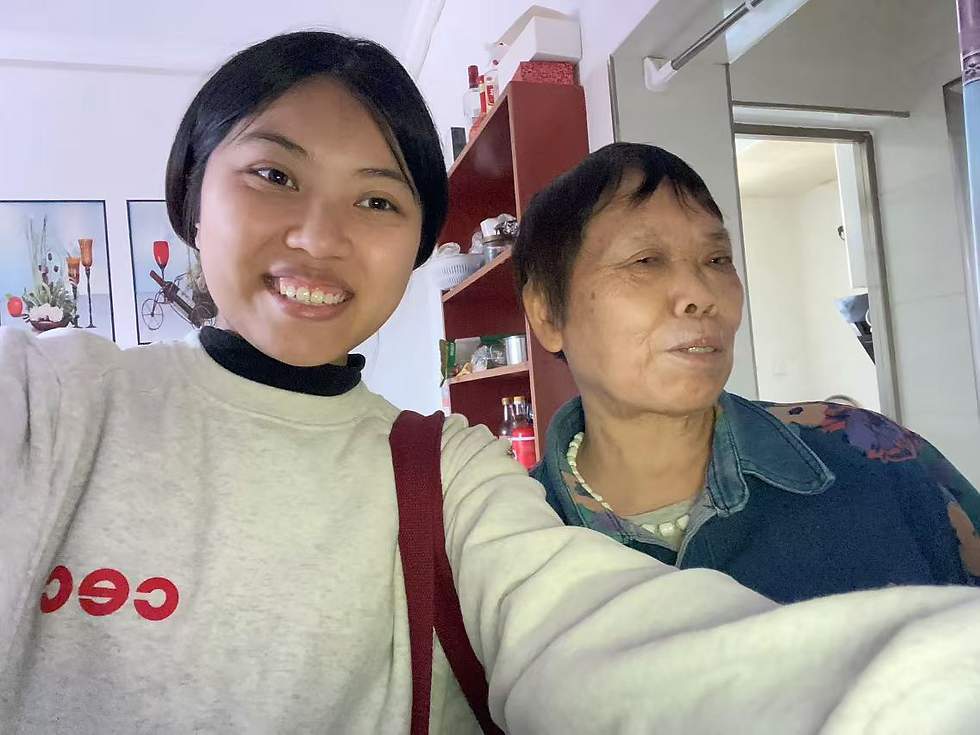




5.Materials
Cardstock, pens, tablecloths, pottery wheel, cutting wire, clay, scrapers, trimming tools, sponges, spray bottles, water buckets, rags, turntables, rolling pins, slip, paints, paintbrushes









6.Courseware






7.Course Implementation
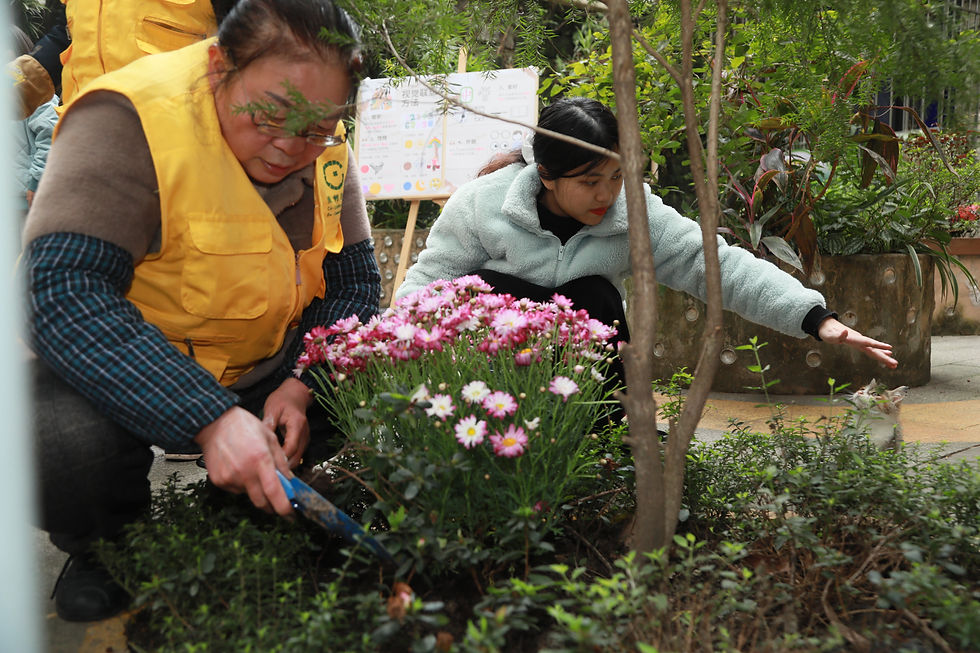
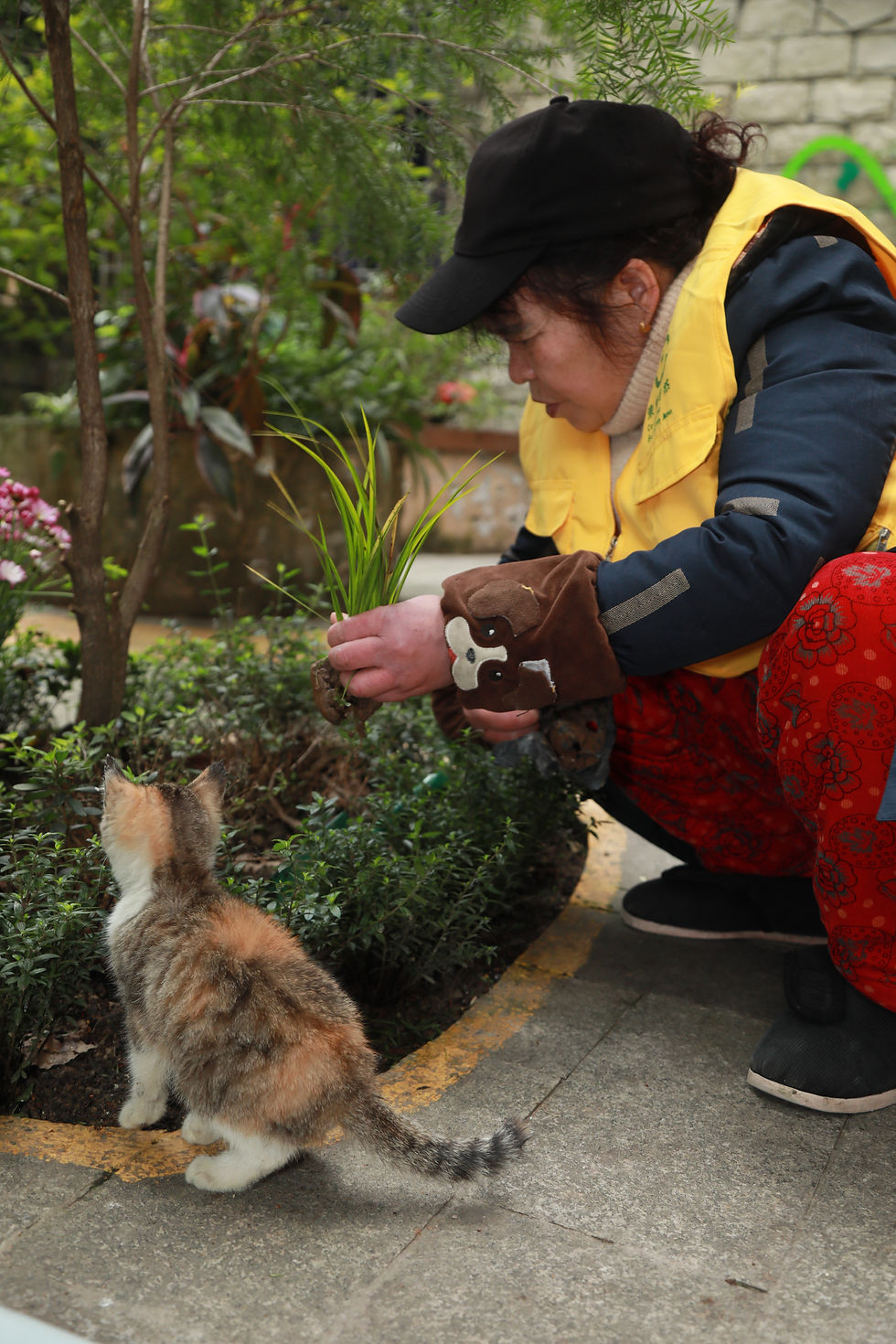

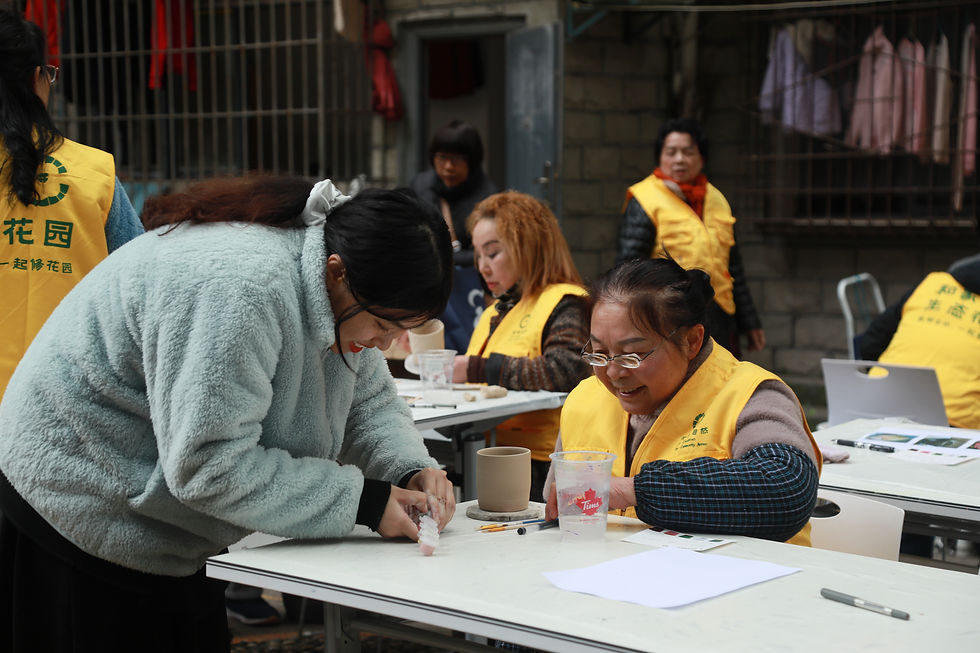
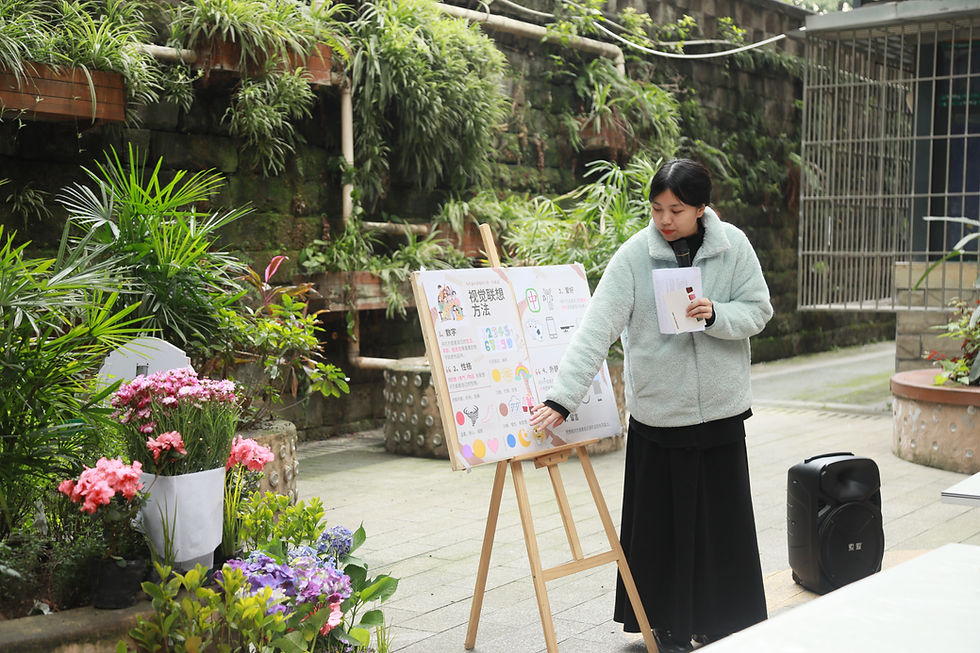

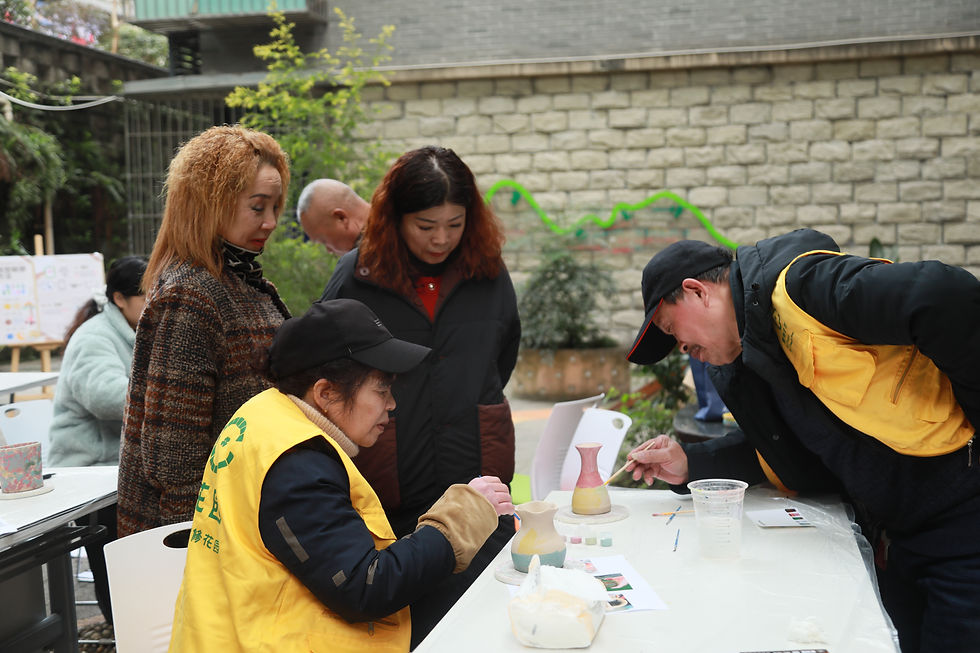
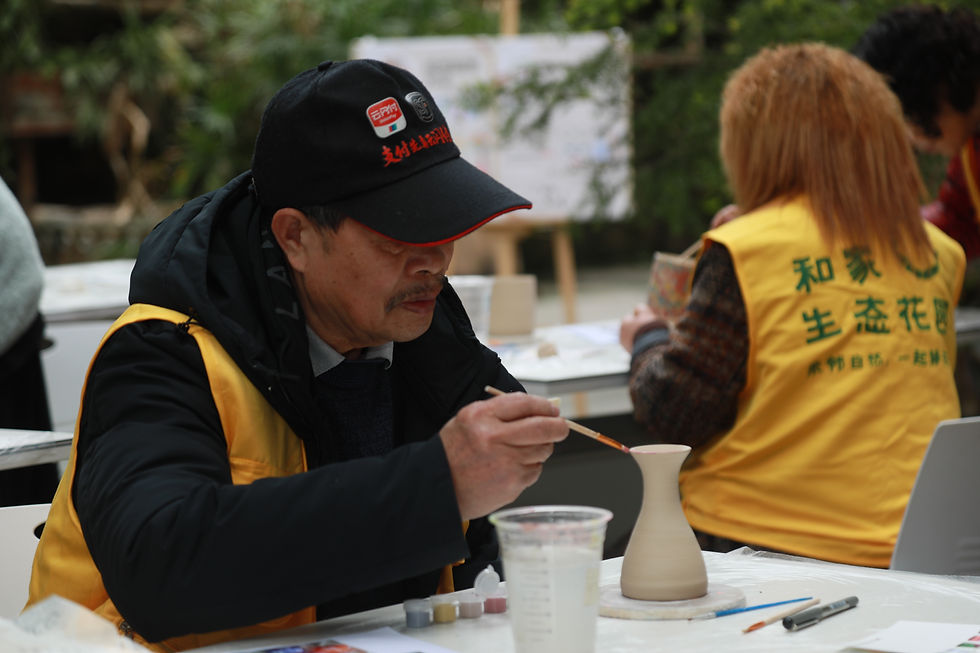


1. Background of the Xingjiaqiao Community
Ecological Garden Project
The Xingjiaqiao Community Ecological Garden Project is a key component of the 2021 “Close-to-Nature Plan” for urban communities (see Table 1-1). It serves as the first model in Chongqing City to explore innovative urban renewal in old districts, promote residents’ engagement in ecological civilization, and advance grassroots social governance. Initiated by Shifang Art Center, the project is hosted by the Chongqing Greening Committee, the Publicity Department of the Chongqing Municipal Committee of the Communist Party of China, the Chongqing Spiritual Civilization Construction Committee Office, the Communist Youth League Chongqing Committee, and the Chongqing Forestry Bureau. The Xingjiaqiao Community in Renhe Street, Liangjiang New Area, Chongqing, serves as the organizing entity, with collaborative efforts from Shifang Art Center, Chongqing Fugui Culture and Art Research Institute, Beijing Gaia Landscape Design Studio, and the School of International Law and Sociology at Sichuan International Studies University.ake a course of art museum education around this exhibition.
The project primarily engaged residents, especially elderly residents, from 16 renovated buildings in the Xingjiaqiao Community and surrounding areas. It transformed underutilized “gray spaces” such as slopes, hardened surfaces, and corners of staircases into micro-ecological gardens. Employing a participatory design approach, the project involved residents in co-planning and co-building these spaces. Alongside the garden construction, aesthetic education courses were conducted, covering stages from research and design to construction and maintenance. To date, 13 activities have been held (see Table 1-2), completing the foundational construction phase. The project has now progressed to the mid-to-long-term phase of collaborative governance and maintenance, which is expected to continue indefinitely.
Name | Location | Area | Land Ownership |
|---|---|---|---|
Xingjiaqiao Community Ecological Garden | Xingjiaqiao Community, Renhe Street, Liangjiang New Area, Chongqing City | 215㎡ | Public |
Table 1-1: Basic Information of the Xingjiaqiao Community Ecological Garden
No | Date | Content |
|---|---|---|
13th | 2024-01-17 | “Co-governance and Sharing of Community and Ecological Nature in Urban Renewal” summary meeting |
12th | 2024-01-14 | Plant pruning, repainting of gates and ground surfaces |
11th | 2023-11-10 | “Early Winter Labor Renewal” co-construction and co-governance activity |
10th | 2023-06-05 | “Let’s Make Eco-Enzymes” co-governance workshop |
9th | 2023-02-15 | “Spring Awakening, Joyful Labor” co-governance workshop |
8th | 2022-06-17 | Party-led “Close-to-Nature” co-governance activity for the Ecological Garden |
7th | 2022-04-24 | Kickoff meeting for co-governance of the Xingjiaqiao Ecological Garden |
6th | 2022-04-01 | Unveiling ceremony for the Xingjiaqiao Ecological Garden |
5th | 2022-02-28 | Co-construction workshop (opening ceremony) for the Xingjiaqiao Ecological Garden |
4th | 2022-02-27 | Co-construction workshop for the Xingjiaqiao Ecological Garden |
3rd | 2021-12-24 | Consensus meeting on the Xingjiaqiao Ecological Garden design plan |
2nd | 2021-11-19 | Participatory design workshop for the Xingjiaqiao Ecological Garden |
1st | 2021-10-15 | Community survey for site selection of the Xingjiaqiao Ecological Garden |
Table 1-2: Timeline and Content of Activities for the Xingjiaqiao Ecological Garden Project

